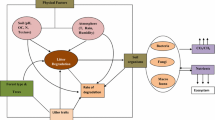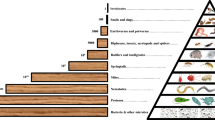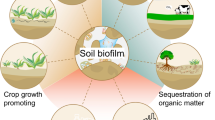Abstract
Decomposition is a dynamic ecological process dependent upon many factors such as environment, climate, and bacterial, insect, and vertebrate activity in addition to intrinsic properties inherent to individual cadavers. Although largely attributed to microbial metabolism, very little is known about the bacterial basis of human decomposition. To assess the change in bacterial community structure through time, bacterial samples were collected from several sites across two cadavers placed outdoors to decompose and analyzed through 454 pyrosequencing and analysis of variable regions 3–5 of the bacterial 16S ribosomal RNA (16S rRNA) gene. Each cadaver was characterized by a change in bacterial community structure for all sites sampled as time, and decomposition, progressed. Bacteria community structure is variable at placement and before purge for all body sites. At bloat and purge and until tissues began to dehydrate or were removed, bacteria associated with flies, such as Ignatzschineria and Wohlfahrtimonas, were common. After dehydration and skeletonization, bacteria associated with soil, such as Acinetobacter, were common at most body sites sampled. However, more cadavers sampled through multiple seasons are necessary to assess major trends in bacterial succession.






Similar content being viewed by others
References
Hyde ER, Haarmann DP, Lynne AM, Bucheli SR, Petrosino JF (2013) The living dead: bacterial community structure of a cadaver at the onset and end of the bloat stage of decomposition. PLoS ONE 8:e77733
Hewadikaram KA, Goff ML (1991) Effect of carcass size on rate of decomposition and arthropod succession patterns. Am J Forensic Med Pathol 12:235–240
Micozzi MS (1996) Frozen environments and soft tissue preservation. In: Forensic taphonomy. CRC Press
Schoenen D, Schoenen H (2013) Adipocere formation—the result of insufficient microbial degradation. Forensic Sci Int 226:301.e301–301.e306
Megyesi MS, Nawrocki SP, Haskell NH (2005) Using accumulated degree-days to estimate the postmortem interval from decomposed human remains. J Forensic Sci 50:618–626
Simmons T, Adlam RE, Moffatt C (2010) Debugging decomposition data—comparative taphonomic studies and the influence of insects and carcass size on decomposition rate. J Forensic Sci 55:8–13
Michaud JP, Moreau G (2011) A statistical approach based on accumulated degree-days to predict decomposition-related processes in forensic studies. J Forensic Sci 56:229–232
Pinheiro J (2006) Decay process of a cadaver. In: Schmitt A, Cunha E, Pinheiro J (eds) Forensic anthropology and medicine. Humana Press, New Jersey, pp 85–116
Galloway A (1996) The process of decomposition. In: Forensic taphonomy. CRC Press
Myburgh J, L’Abbé EN, Steyn M, Becker PJ (2013) Estimating the postmortem interval (PMI) using accumulated degree-days (ADD) in a temperate region of South Africa. Forensic Sci Int 229:165.e161–165.e166
Janaway R, Percival S, Wilson A (2009) Decomposition of human remains. In: Percival S (ed) Microbiology and aging. Humana Press, p 313–334
Vass A (2001) Beyond the grave—understanding human decomposition. Microbiol Today 28:190–192
Catts EP, Haskell NH (1990) Entomology & death: a procedural guide. Joyce’s Print Shop, Incorporated, Clemson
Byrd JH, Castner JL (2000) Insects of forensic importance. In: Forensic entomology. CRC Press, p 43–79
Haskell NH, Williams RE (2008) Entomology & death: a procedural guide, 2nd edn. East Park Printing, Clemson
Schoenly KG, Haskell NH, Mills DK, Bieme-ndi C, Larsen K, Lee Y (2006) Recreating death’s acre in the school yard: using pig carcasses as model corpses to teach concepts of forensic entomology and ecological succession. Am Biol Teach 68:402–410
Pless JE, Worrell MB, Clark MA (1996) Postmortem changes in soft tissues. In: Forensic taphonomy. CRC Press
Butzbach DM, Stockham PC, Kobus HJ, Sims DN, Byard RW, Lokan RJ, Walker GS (2013) Bacterial degradation of risperidone and paliperidone in decomposing blood. J Forensic Sci 58:90–100
Dickson GC, Poulter RTM, Maas EW, Probert PK, Kieser JA (2011) Marine bacterial succession as a potential indicator of postmortem submersion interval. Forensic Sci Int 209:1–10
Howard GT, Duos B, Watson-Horzelski EJ (2010) Characterization of the soil microbial community associated with the decomposition of a swine carcass. Int Biodeterior Biodegrad 64:300–304
Lenz EJ, Foran DR (2010) Bacterial profiling of soil using genus-specific markers and multidimensional scaling. J Forensic Sci 55:1437–1442
Carter DO, Yellowlees D, Tibbett M (2008) Temperature affects microbial decomposition of cadavers (Rattus rattus) in contrasting soils, Faculty Publications, Department of Entomology
Kakizaki E, Takahama K, Seo Y, Kozawa S, Sakai M, Yukawa N (2008) Marine bacteria comprise a possible indicator of drowning in seawater. Forensic Sci Int 176:236–247
Meyers MS, Foran DR (2008) Spatial and temporal influences on bacterial profiling of forensic soil samples. J Forensic Sci 53:652–660
Melvin JR Jr, Cronholm LS, Simson LR Jr, Isaacs AM (1984) Bacterial transmigration as an indicator of time of death. J Forensic Sci 5329:412–417
Evans WED (1963) The chemistry of death. Charles C. Thomas, Springfield
Pechal JL, Crippen TL, Benbow ME, Tarone AM, Dowd S, Tomberlin JK (2014) The potential use of bacterial community succession in forensics as described by high throughput metagenomic sequencing. Int J Legal Med 128(1):193–205
Metcalf JL, Wegener Parfrey L, Gonzalez A, Lauber CL, Knights D, Ackermann G, Humphrey GC, Gebert MJ, Van Treuren W, Berg-Lyons D, Keepers K, Guo Y, Bullard J, Fierer N, Carter DO, Knight R (2013) A microbial clock provides an accurate estimate of the postmortem interval in a mouse model system. eLife 2:e01104
McClintock WR, Castille JJ, Stewart M, Andrew IE (1979) Soil Survey of Walker County, Texas. U.S. Soil Conservation Service
Human Microbiome Project C (2012) A framework for human microbiome research. Nature 486:215–221
Human Microbiome Project C (2012) Structure, function and diversity of the healthy human microbiome. Nature 486:207–214
Caporaso JG, Kuczynski J, Stombaugh J, Bittinger K, Bushman FD, Costello EK, Fierer N, Pena AG, Goodrich JK, Gordon JI, Huttley GA, Kelley ST, Knights D, Koenig JE, Ley RE, Lozupone CA, McDonald D, Muegge BD, Pirrung M, Reeder J, Sevinsky JR, Turnbaugh PJ, Walters WA, Widmann J, Yatsunenko T, Zaneveld J, Knight R (2010) QIIME allows analysis of high-throughput community sequencing data. Nat Methods 7:335–336
Toth E, Farkas R, Marialigeti K, Mokhtar IS (1998) Bacteriological investigations on wound myiasis of sheep caused by Wohlfahrtia magnifica (Diptera: Sarcophagidae). Acta Vet Hung 46:219–229
Toth E, Kovacs G, Schumann P, Kovacs AL, Steiner U, Halbritter A, Marialigeti K (2001) Schineria larvae gen. nov., sp. nov., isolated from the 1st and 2nd larval stages of Wohlfahrtia magnifica (Diptera: Sarcophagidae). Int J Syst Evol Microbiol 51:401–407
Toth EM, Borsodi AK, Euzeby JP, Tindall BJ, Marialigeti K (2007) Proposal to replace the illegitimate genus name Schineria Toth et al. 2001 with the genus name Ignatzschineria gen. nov. and to replace the illegitimate combination Schineria larvae Toth et al. 2001 with Ignatzschineria larvae comb. nov. Int J Syst Evol Microbiol 57:179–180
Toth EM, Schumann P, Borsodi AK, Keki Z, Kovacs AL, Marialigeti K (2008) Wohlfahrtiimonas chitiniclastica gen. nov., sp. nov., a new gammaproteobacterium isolated from Wohlfahrtia magnifica (Diptera: Sarcophagidae). Int J Syst Evol Microbiol 58:976–981
Rebaudet S, Genot S, Renvoise A, Fournier PE, Stein A (2009) Wohlfahrtiimonas chitiniclastica bacteremia in homeless woman. Emerg Infect Dis 15:985–987
Baumann P (1968) Isolation of Acinetobacter from soil and water. J Bacteriol 96:39–42
Bergogne-Berezin E, Towner KJ (1996) Acinetobacter spp. as nosocomial pathogens: microbiological, clinical, and epidemiological features. Clin Microbiol Rev 9:148–165
Zhang X, Glennie CL, Bucheli SR, Lynne AM (2014) Terrestrial laser scanning and a degenerated cylinder model to determine gross morphological change of cadavers under conditions of natural decomposition. Forensic Sci Int 241:35–45
Bucheli SR, Pan Z, Glennie CL, Lynne AM, Haarmann DP, Hill JM (2014) Terrestrial laser scanning to model sunlight irradiance on cadavers under conditions of natural decomposition. Int J Legal Med 128(4):725–732
Acknowledgments
The authors would like to extend our appreciation to the donors and their families; without them, this research would not be possible. Bucheli and Lynne would like to thank Natalie Lindgren, Brent Rahlwes, Melissa Sisson, James Willett, and Jordan Baker for field assistance and Chris Randle and James Harper for intellectual contribution. The authors would like to thank Dr. Joan Bytheway and Kevin Derr at the STAFS facility.
Author information
Authors and Affiliations
Corresponding author
Electronic supplementary material
Below is the link to the electronic supplementary material.
Online Resource 1
Stages of decomposition targeted for sampling: A) day of placement; B) pre-bloat; C) bloat; D) purge; E) putrefaction; and F) skeletonization. (JPEG 1403 kb)
Online Resource 2
Box and whisker plots illustrating the median, minimum, maximum, first quartile, and third quartile for (a) the number of observed species and (b) the Shannon diversity index of right and left bicep samples collected from STAFS 2012-021. Alpha diversity metrics were calculated on a sequencing depth of 910 sequences per sample. (JPEG 202 kb)
Online Resource 3
Box and whisker plots illustrating the median, minimum, maximum, first quartile, and third quartile for (a) the number of observed species and (b) the Shannon diversity index of right and left bicep samples collected from STAFS 2012-023. Alpha diversity metrics were calculated on a sequencing depth of 910 sequences per sample. (JPEG 196 kb)
Online Resource 4
Percent abundances through time of major genera across all body sites, STAFS 2012-021. (DOCX 141 kb)
Online Resource 5
Percent abundances through time of major genera across all body sites, STAFS 2012-023. (DOCX 132 kb)
Rights and permissions
About this article
Cite this article
Hyde, E.R., Haarmann, D.P., Petrosino, J.F. et al. Initial insights into bacterial succession during human decomposition. Int J Legal Med 129, 661–671 (2015). https://doi.org/10.1007/s00414-014-1128-4
Received:
Accepted:
Published:
Issue Date:
DOI: https://doi.org/10.1007/s00414-014-1128-4




